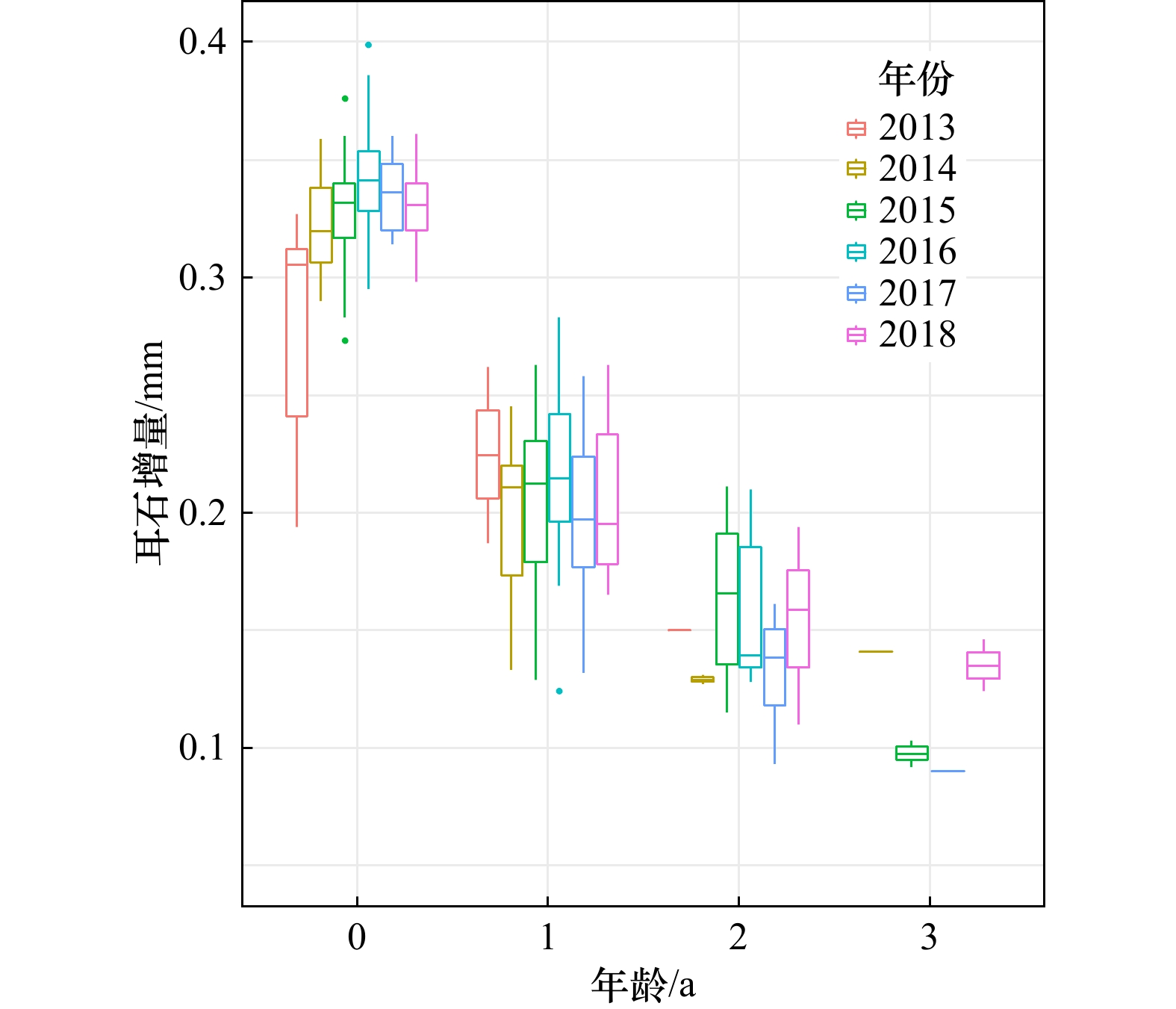Growth dynamics of Pholis fangi in Haizhou Bay and influencing factors explored by mixed-effect models
-
摘要: 本研究利用2015−2019年海州湾方氏云鳚(Pholis fangi)耳石样本,基于线性混合效应模型(LMEM)研究了方氏云鳚在2013−2018年内生长速度的年际变化,评估了不同年龄阶段的方氏云鳚的生长对底层温度、叶绿素含量和种群密度等外界因素的响应。结果表明:方氏云鳚个体在不同年龄的耳石增量具有明显差异,0龄平均耳石增量为0.327 mm,显著高于高龄耳石增量。模型随机效应表明,方氏云鳚的生长速度在2013−2016年呈现逐步变快的趋势,在2016−2018年波动较为明显。方氏云鳚0龄时期生长速度的主要影响因素为底层温度和种群密度,其生长速度随温度的上升先加快后降低,随种群密度的增加而降低。方氏云鳚1龄时期的生长速度受底层温度和饵料等环境因素的影响不显著,体现了成体对环境的适应能力。本研究深入解析了鱼类的生长动态对生物和非生物因素的响应,有助于应对未来气候变化对渔业生态系统的影响。Abstract: According to the Pholis fangi otoliths collected from bottom-trawl surveys in Haizhou Bay during from 2015 to 2019, linear mixed-effects model (LMEM) was used to study the interannual variation of growth rate of P. fangi from 2013 to 2018 and assess the response of the growth of P. fangi at different ages to external environmental factors such as bottom temperature, chlorophyll content and population density. The results showed that the otolith increment of P. fangi differed significantly between ages, with the mean otolith increment of 0.327 mm at 0 year old, significantly higher than that at another ages. The random-effects showed that the growth rate of P. fangi showed an increasing trend from 2013 to 2015, with a fluctuating trend from 2016 to 2018. The main factors affecting the growth of P. fangi at 0 year old were bottom temperature and population density. The growth rate increased and then decreased with the increase of bottom temperature, and decreased with the increase of population density. The effect of environmental factors on the growth rate of P. fangi at 1 year old were not significant, reflecting the ability of adults to adapt to the environment. This study provided insight into the growth dynamics of fish in response to biotic and abiotic factors, which will help to cope with the impact of climate change on fishery ecosystems.
-
Key words:
- Pholis fangi /
- otolith /
- environmental factors /
- growth rate /
- linear mixed-effects model /
- Haizhou Bay
-
表 1 方氏云鳚不同年龄耳石增量的变异性
Tab. 1 Variation of otolith increment of Pholis fangiat different ages
年龄/a 耳石增量范围/mm 平均值/mm 标准差 变异系数/% 0 0.194~0.399 0.327 0.028 8.68 1 0.124~0.283 0.204 0.036 17.77 2 0.093~0.211 0.151 0.030 19.81 3 0.090~0.146 0.116 0.025 21.15 表 2 内因模型的拟合
Tab. 2 Fitting of the best intrinsic model
模型 固定效应 随机效应 AICc 边际R2 条件R2 M1 Age (1|FishID) −934.11 0.841 0.845 M2 Age (1|FishID)+(1|Cohort) −932.10 0.841 0.844 M3 Age (1|FishID)+(1|Year) −940.77 0.835 0.859 注:(1|FishID)、(1|Cohort)和(1|Year)分别为个体编号、世代和年份的截距随机效应;Age为年龄固定效应。 表 3 因子多重共线性检验结果
Tab. 3 Results of multicollinearity test of factors
因子 全年 春季 夏季 秋季 冬季 底层温度 1.041 4.048 2.356 6.145 3.280 叶绿素含量 2.282 2.403 2.250 2.280 2.496 种群密度 2.233 2.146 1.080 4.174 1.568 注: 表中数字为方差膨胀因子。 表 4 最优外因模型筛选结果
Tab. 4 Results of best extrinsic models screening
年龄 模型 模型结构 AICc R2 0龄 Model 1 BT −467.35 0.229 Model 2 SprBT + Chl + Den −470.49 0.283 Model 3 SumBT + SumBT2 −467.59 0.247 Model 4 AutBT + AutBT2 + Chl −469.39 0.275 Model 5 WinBT + Chl + Den −473.10 0.301 1龄 Model 6 BT −349.98 0.025 Model 7 SprBT −349.24 0.017 Model 8 SumBT −349.23 0.017 Model 9 Den+Chl −348.16 0.029 Model 10 WinBT −348.46 0.009 注: BT、SprBT、SumBT、AutBT、WinBT、Chl和Den分别代表全年平均底温、春季平均底温、夏季平均底温、秋季平均底温、冬季平均底温、叶绿素含量和种群密度。 -
[1] Schwamborn R, Mildenberger T K, Taylor M H. Assessing sources of uncertainty in length-based estimates of body growth in populations of fishes and macroinvertebrates with bootstrapped ELEFAN[J]. Ecological Modelling, 2019, 393: 37−51. doi: 10.1016/j.ecolmodel.2018.12.001 [2] 任晓明, 徐宾铎, 张崇良, 等. 海州湾及邻近海域鱼类群落的营养功能群及其动态变化[J]. 中国水产科学, 2019, 26(1): 141−150. doi: 10.3724/SP.J.1118.2019.18149Ren Xiaoming, Xu Binduo, Zhang Chongliang, et al. The composition of and variations in the trophic guilds of fish assemblages in Haizhou Bay and adjacent waters[J]. Journal of Fishery Sciences of China, 2019, 26(1): 141−150. doi: 10.3724/SP.J.1118.2019.18149 [3] Brander K. Impacts of climate change on fisheries[J]. Journal of Marine Systems, 2010, 79(3/4): 389−402. [4] 王琨, 张崇良, 陈宁, 等. 基于Bootstrap的ELEFAN方法在评估方氏云鳚群体生长参数中的应用[J]. 中国水产科学, 2019, 26(3): 512−521. doi: 10.3724/SP.J.1118.2019.18329Wang Kun, Zhang Chongliang, Chen Ning, et al. Evaluating the growth parameters of Pholis fangi based on the Bootstrap-ELEFAN method[J]. Journal of Fishery Sciences of China, 2019, 26(3): 512−521. doi: 10.3724/SP.J.1118.2019.18329 [5] Zuur A F, Ieno E N, Walker N J, et al. Mixed Effects Models and Extensions in Ecology with R[M]. New York: Springer, 2009. [6] Ma Qiuyun, Jiao Yan, Ren Yiping. Linear mixed-effects models to describe length-weight relationships for yellow croaker (Larimichthys polyactis) along the north coast of China[J]. PLoS One, 2017, 12(2): e0171811. doi: 10.1371/journal.pone.0171811 [7] Mu Xiuxia, Zhang Chongliang, Xu Binduo, et al. Varying growth rates of a marine eel, the whitespotted conger (Conger myriaster), are explained by the interaction between seasonal temperature and prey availability[J]. Marine Biology, 2022, 169(1): 6. doi: 10.1007/s00227-021-03976-y [8] Xu Binduo, Zhang Chongliang, Xue Ying, et al. Optimization of sampling effort for a fishery-independent survey with multiple goals[J]. Environmental Monitoring and Assessment, 2015, 187(5): 252. doi: 10.1007/s10661-015-4483-9 [9] 中华人民共和国国家质量监督检验检疫总局, 中国国家标准化管理委员会. GB/T 12763. 6−2007, 海洋调查规范, 第6部分: 海洋生物调查[S]. 北京: 中国标准出版社, 2007.General Administration of Quality Supervision, Inspection and Quarantine of the People’s Republic of China, Standardization Administration of the People’s Republic of China. GB/T 12763.6−2007, Specifications for oceanographic survey. Part 6: Marine biological survey[S]. Beijing: Standards Press of China, 2007. [10] Xing Qinwang, Yu Huaming, Yu Haiqing, et al. A comprehensive model-based index for identification of larval retention areas: a case study for Japanese anchovy Engraulis japonicus in the Yellow Sea[J]. Ecological Indicators, 2020, 116: 106479. doi: 10.1016/j.ecolind.2020.106479 [11] Sugiura N. Further analysts of the data by akaike’s information criterion and the finite corrections: Further analysts of the data by akaike’s[J]. Communications in Statistics-Theory and Methods, 1978, 7(1): 13−26. doi: 10.1080/03610927808827599 [12] Hwang S D, Lee T W, Hwang S W. Age, growth and life history of gunnel, Pholis fangi, in the Yellow Sea[J]. Fisheries Research, 2008, 93(1−2): 72−76. doi: 10.1016/j.fishres.2008.02.011 [13] Gao Guandong, Marin M, Feng Ming, et al. Drivers of marine heatwaves in the East China Sea and the South Yellow Sea in three consecutive summers during 2016–2018[J]. Journal of Geophysical Research: Oceans, 2020, 125(8): e2020JC016518. [14] Stokes K, Law R. Fishing as an evolutionary force[J]. Marine Ecology Progress Series, 2000, 208: 307−309. [15] 毕远溥. 方氏云鳚渔业生物学及其在辽宁沿海的渔业[J]. 水产科学, 2005, 24(9): 27−28. doi: 10.3969/j.issn.1003-1111.2005.09.009Bi Yuanpu. Biology and its fishery of Fang’s blenny Enedrias fangi Wang et Wang in offshore in Liaoning Province[J]. Fisheries Science, 2005, 24(9): 27−28. doi: 10.3969/j.issn.1003-1111.2005.09.009 [16] 于非, 张志欣, 刁新源, 等. 黄海冷水团演变过程及其与邻近水团关系的分析[J]. 海洋学报, 2006, 28(5): 26−34.Yu Fei, Zhang Zhixin, Diao Xinyuan, et al. Analysis of evolution of the Huanghai Sea cold water mass and its relationship with adjacent water masses[J]. Haiyang Xuebao, 2006, 28(5): 26−34. [17] 李敏, 李增光, 徐宾铎, 等. 时空和环境因子对海州湾方氏云鳚资源丰度分布的影响[J]. 中国水产科学, 2015, 22(4): 812−819.Li Min, Li Zengguang, Xu Binduo, et al. Effects of spatiotemporal and environmental factors on the distribution and abundance of Pholis fangi in Haizhou Bay using a generalized additive model[J]. Journal of Fishery Sciences of China, 2015, 22(4): 812−819. [18] 张崇良, 徐宾铎, 薛莹, 等. 渔业资源增殖评估研究进展与展望[J]. 水产学报, 2022, 46(8): 1509−1524.Zhang Chongliang, Xu Binduo, Xue Ying, et al. Fisheries stock enhancement assessment: Progress and prospect[J]. Journal of Fisheries of China, 2022, 46(8): 1509−1524. [19] Lorenzen K, Enberg K. Density-dependent growth as a key mechanism in the regulation of fish populations: evidence from among-population comparisons[J]. Proceedings of the Royal Society of London. Series B: Biological Sciences, 2002, 269(1486): 49−54. doi: 10.1098/rspb.2001.1853 [20] Fowler C W. Density dependence as related to life history strategy[J]. Ecology, 1981, 62(3): 602−610. doi: 10.2307/1937727 [21] Fey D P. The effect of temperature and somatic growth on otolith growth: the discrepancy between two clupeid species from a similar environment[J]. Journal of Fish Biology, 2006, 69(3): 794−806. doi: 10.1111/j.1095-8649.2006.01151.x [22] Ward A J W, Webster M M, Hart P J B. Intraspecific food competition in fishes[J]. Fish and Fisheries, 2006, 7(4): 231−261. doi: 10.1111/j.1467-2979.2006.00224.x [23] Andersson A, Haecky P, Hagström Å. Effect of temperature and light on the growth of micro-nano-and pico-plankton: impact on algal succession[J]. Marine Biology, 1994, 120(4): 511−520. doi: 10.1007/BF00350071 [24] Mazumder A, Taylor W D, McQueen D J, et al. Effects of fish and plankton on lake temperature and mixing depth[J]. Science, 1990, 247(4940): 312−315. doi: 10.1126/science.247.4940.312 [25] Schlosser I J. Fish recruitment, dispersal, and trophic interactions in a heterogeneous lotic environment[J]. Oecologia, 1998, 113(2): 260−268. doi: 10.1007/s004420050377 [26] Dettmers J M, Wahl D H. Evidence for zooplankton compensation and reduced fish growth in response to increased juvenile fish density[J]. Hydrobiologia, 1999, 400: 115−121. doi: 10.1023/A:1003767331606 [27] Hilborn R, Walters C J. Quantitative Fisheries Stock Assessment: Choice, Dynamics and Uncertainty[M]. New York: Springer, 1992. [28] 刘逸文, 张崇良, 刘淑德, 等. 山东近海口虾蛄单位补充量渔获量评估[J]. 水产学报, 2020, 44(2): 213−221.Liu Yiwen, Zhang Chongliang, Liu Shude, et al. Yield per recruitment evaluation of Oratosquilla oratoria in coastal waters of Shandong[J]. Journal of Fisheries of China, 2020, 44(2): 213−221. [29] Shin Y J, Cury P. Exploring fish community dynamics through size-dependent trophic interactions using a spatialized individual-based model[J]. Aquatic Living Resources, 2001, 14(2): 65−80. doi: 10.1016/S0990-7440(01)01106-8 [30] Sekigawa T, Takahashi T, Takatsu T. Age and growth of fat greenling Hexagrammos otakii in Kikonai Bay, Hokkaido[J]. Aquaculture Science, 2002, 50(4): 395−400. [31] Morrongiello J R, Thresher R E. A statistical framework to explore ontogenetic growth variation among individuals and populations: a marine fish example[J]. Ecological Monographs, 2015, 85(1): 93−115. doi: 10.1890/13-2355.1 [32] 姜志强, 秦克静. 大连地区方氏云鳚的年龄和生长[J]. 大连水产学院学报, 1990(1): 33−41.Jiang Zhiqiang, Qin Kejing. Age and growth of Enedrias Fangi in Dalian[J]. Journal of Dalian Ocean University, 1990(1): 33−41. [33] Battaglia P, Malara D, Romeo T, et al. Relationships between otolith size and fish size in some mesopelagic and bathypelagic species from the Mediterranean Sea (Strait of Messina, Italy)[J]. Scientia Marina, 2010, 74(3): 605−612. doi: 10.3989/scimar.2010.74n3605 [34] Morales-Nin B. Review of the growth regulation processes of otolith daily increment formation[J]. Fisheries Research, 2000, 46(1/3): 53−67. [35] 朱建成, 赵宪勇, 李富国. 黄海鳀鱼的生长特征及其年际与季节变化[J]. 海洋水产研究, 2007, 28(3): 64−72.Zhu Jiancheng, Zhao Xianyong, Li Fuguo. Growth characters of the anchovy stock in the Yellow Sea with its annual and seasonal variations[J]. Marine Fisheries Reseach, 2007, 28(3): 64−72. [36] Newman D, Carruthers T, MacCall A, et al. Improving the science and management of data-limited fisheries: an evaluation of current methods and recommended approaches[R]. New York: Natural Resources Defense Council, 2014. -





 下载:
下载:





